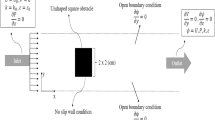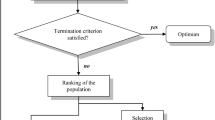Abstract
Mesh quality issues can have a substantial impact on the solution process in Computational Fluid Dynamics, leading to poor quality solutions, hindering convergence and in some cases, causing the solution to diverge. In many areas of application, there is an interest in automated generation of finite volume meshes, where a meshing algorithm controlled by pre-specified parameters is applied to a pre-existing CAD geometry. In such cases, the user is typically confronted with a large number of controllable parameters, and adjusting these takes time and perseverance. The process can, however, be regarded as a multi-input and possibly multi-objective optimisation process which can be optimised by application of Genetic Algorithm techniques. We have developed a GA optimisation code in the language Python, including an implementation of the NGSA-II multi-objective optimisation algorithm, and applied to control the mesh generation process using the snappyHexMesh automated mesher in OpenFOAM. We demonstrate the results on three selected cases, demonstrating significant improvement in mesh quality in all cases.













Similar content being viewed by others
References
Abe K, Ohtsuka T (1984) Some salient features of the time-averaged ground vehicle wake. In: Technical report SAE-paper 840300. SAE, Warrendale
Baker M, Daniels S, Young P, Tabor G (2014) Investigation of ow through a computationally generated packed column using CFD and additive layer manufacturing. Comput Chem Eng 67:159–165
Baker MJ, Tabor GR (2010) Computational analysis of transitional airflow through packed columns of spheres using the finite volume technique. Comput Chem Eng 34:878–885
Behzadian K, Kapelan Z, Savic D, Ardeshir A (2009) Stochastic sampling design using a multi-objective genetic algorithm and adaptive neural networks. Environ Model Softw 24:530–541
Berzins M (1999) Mesh quality: a function of geometry, error estimates, or both? Eng Comput 15(3):236–247
Deb K, Anand A, Joshi D (2002) A computationally efficient evolutionary algorithm for real-parameter optimization. Evol Comput 10(4):371–395
Diskin B, Thomas J (2012) Effects of mesh regularity on accuracy of finite-volume schemes. In: 50th AIAA aerospace sciences meeting including the new horizons forum and aerospace exposition, 2012-0609. AIAA, New York
Field D (1988) Laplacian smoothing and Delaunay triangulations. Commun Numer Methods 4:709–712
Field D (2000) Qualitative measures for initial meshes. Int J Numer Methods Eng 47:887–906
Fonseca CM, Fleming PJ (1995) An overview of evolutionary algorithms in multiobjective optimization. Evol Comput 3:1–16
Freitag L (2001) Local optimization-based untangling algorithms for quadrilateral meshes. In: Proceedings of the 10th international meshing roundtable, Newport Beach, pp 397–406. Sandia National Laboratories, New Mexico
Freitag L, Jones M, Plassmann P (1999) A parallel algorithm for mesh smoothing. SIAM J Sci Comput 20(6):2023–2040
Gagné C, Parizeau M (2006) Genericity in evolutionary computation software tools; principles and case-study. Int J Artif Intell Tools 15(2):173–194
Goldberg DE (1989) Genetic algorithms in search, optimization, and machine learning. Addison-Wesley, New York
Hinterberger C, Garca-Villalba M, Rodi W (2004) Large eddy simulation of flow around the Ahmed body. In: McCallen JRR, Browand F (eds) Lecture notes in applied and computational mechanics/the aerodynamics of heavy vehicles: trucks, buses, and trains. Springer, New York
Jasak H (1996) Error analysis and estimation for the finite volume method with applications to fluid flows. Ph.D. thesis, Imperial College
Jeng Y, Chen J (1992) Truncation error analysis of the finite volume method for a model steady convective equation. J Comput Phys 100:64–76
Jourdan L, Corne D, Savic D, Walters G (2005) Preliminary investigation of the learnable evolution model for faster/better multiobjective water systems design. In: Proceedings of the third international conference on evolutionary multi-criterion optimization, EMO 05
Kallinderis Y, Kontzialis C (2009) A priori mesh quality estimation via direct relation between truncation error and mesh distortion. J Comput Phys 228:881–902
Knupp P (2000) Achieving finite element mesh quality via optimization of the Jacobian matric norm and associated quantities. Part 1. A framework for surface mesh optimization. Int J Numer Methods Eng 48:401–420
Knupp P (2000) Achieving finite element mesh quality via optimization of the Jacobian matric norm and associated quantities. Part 2. A framework for volume mesh optimization. Int J Numer Methods Eng 48:1165–1185
Knupp P (2001) Algebraic mesh quality metrics. SIAM J Sci Comput 23(1):192–218
Knupp P (2003) Algebraic mesh quality metrics for unstructured initial meshes. Finite Elem Anal Des 39:217–241
Krajnovic S, Davidson L (2005) Flow around a simplified car. Part 2: Understanding the flow. J Fluids Eng 127(5):919–928
Krajnovic S, Davidson L (2005) Flow around a simplified car. Part 1: Large Eddy simulations. J Fluids Eng 127(5):907–918
Lienhart H, Becker S (2003) Flow and turbulence structure in the wake of a simplified car model. In: SAE 2003 world congress, Detroit
Lienhart H, Stoots C, Becker S (2000) Flow and turbulence structures in the wake of a simplified car model (Ahmed model). In: DGLR Fach symposium der AG STAB, Stuttgart University
McRae D, Laflin K (1999) Dynamic grid adaption and grid quality. In: Thompson J, Soni B, Weatherhill N (eds) Handbook of grid generation, chap 34. CRC Press, London
Message Passing Interface Forum (2009) MPI: a message-passing interface standard, version 2.2. High-Performance Computing Center, Stuttgart
Michalewicz Z (1996) Genetic algorithms \(+\) data structures \(=\) evolution programs. Springer, Berlin
Minguez M, Pasquetti R, Serre E (2008) High-order large-Eddy simulation of flow over the ’Ahmed body’ car model. Phys Fluids 20(9):095101
Owen SJ, Shelton TR (2014) Evaluation of grid-based hex meshes for solid mechanics. Eng Comput 1–15. doi:10.1007/s00366-014-0368-8
Pagnutti D, Ollivier-Gooch C (2010) Two-dimensional Delaunay-based anisotropic mesh adaption. Eng Comput 26:407–418
Parthasarathy V, Graichen C, Hathaway A (1993) A comparison of tetrahedron quality measures. Finite Elem Anal Des 15:255–261
Robinson J (1994) Quadrilateral and hexahedron shape parameters. Finite Elem Anal Des 16:43–52
Shepherd JF, Johnson CR (2008) Hexahedral mesh generation constraints. Eng Comput 24(3):195–213
Srinivas N, Deb K (1995) Multiobjective optimization using nondominated sorting in genetic algorithms. Evol Comput 2(3):221–248
Versteeg HK, Malalasekera W (1995) An introduction to computational fluid dynamics : the finite volume method. Longman Scientific & Technical, New York
Weller HG, Tabor G, Jasak H, Fureby C (1998) A tensorial approach to computational continuum mechanics using object orientated techniques. Comput Phys 12(6):620–631
Zang Y, Street RL, Koseff JR (1994) A non-staggered grid, fractional step method for time-dependent incompressible Navier–Stokes equations in curvilinear coordinates. J Comput Phys 114(1):18–33
Zitzler E, Laumanns M, Bleuler S (2000) Comparison of multiobjective evolutionary algorithms: empirical results. Evol Comput 8:173–195
Author information
Authors and Affiliations
Corresponding author
Rights and permissions
About this article
Cite this article
Fabritius, B., Tabor, G. Improving the quality of finite volume meshes through genetic optimisation. Engineering with Computers 32, 425–440 (2016). https://doi.org/10.1007/s00366-015-0423-0
Received:
Accepted:
Published:
Issue Date:
DOI: https://doi.org/10.1007/s00366-015-0423-0




